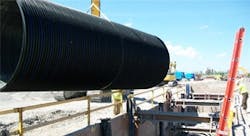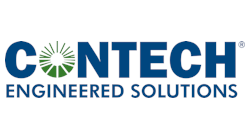In Niagara Falls, N.Y., three engineering firms were involved in different phases of design for a new intermodal facility for Covanta—one of the world’s largest owners and operators of infrastructure for the conversion of waste to energy. Contech Engineered Solutions provided assistance with the storm water management system required in conjunction with this rail-to-truck intermodal facility being constructed as part of the expansion project for Covanta Niagara. This system was unique in that it would help to facilitate the handling of runoff from one of approximately 100 waste-to-energy (WTE) facilities in use across the United States (according to the U.S. EPA website) and was the second in which Contech had been directly involved. Energy recovery from waste is the conversion of non-recyclable waste materials into useable heat, electricity or fuel through a variety of processes, including but not limited to combustion, gasification, pyrolization, anaerobic digestions and landfill gas recovery.
In addition to providing essential trash disposal services for cities and towns across the country, today’s WTE plants generate clean, renewable energy. Through the combustion of everyday household trash in facility with state-of-the-art environmental controls, these facilities play a key role in providing viable alternatives to communities that would otherwise have no option but to buy power from conventional power plants and dispose of their trash in landfills.
The engineering team at AECOM worked closely with the Covanta Niagara Resource Recovery Facility to design and implement a storm water management system that would retain runoff from the WTE plant. The facility processes 2,250 tons of waste per day, selling the steam to adjacent chemical facilities and the electricity to the New York state power grid.
In preparation for the development of the intermodal facility’s planned expansion project, AECOM teamed up with Contech to design a DuroMaxx steel reinforced polyethylene (SRPE) storage tank and two CDS pretreatment systems to handle much of the contaminated runoff associated with the plant’s day-to-day activities. The 96-in.-diameter DuroMaxx system runs 383 linear ft, with bulkheads at both ends and two access risers. The system was capable of 18,655 cu ft of storage (approximately 140,000 gal), while pretreatment by a CDS 2020-5 unit and a 4040-8 unit would provide 100% capture of trash and debris and ensure that all treated runoff meets the New York State Department of Environmental Conservation’s water quality requirements and goals. As part of the design, the DuroMaxx storage system was required to maintain a low leakage rate of less than 100 gal per day. With a 30-psi welded coupler joint, DuroMaxx provided an optimal solution. Both the DuroMaxx system and the CDS pretreatment units would need to meet a TS-9972 Reach Stacker load rating, allowing for a 99,000-lb load. The runoff would be captured and retained in this unique system prior to being pumped to the local wastewater treatment plant for true treatment.
This expansion project is situated on approximately 15 acres along the railroad tracks on the eastern edge of a large former industrial complex located on 47th Street in the City of Niagara Falls. It is a continued effort by Covanta as part of the Brownfield Cleanup Program, which New York state enacted to encourage the voluntary cleanup of contaminated properties known as “brownfields” so that they can be reused and redeveloped. Covanta Niagara is just one of more than 40 national Voluntary Protection Programs star facilities operated by Covanta.



